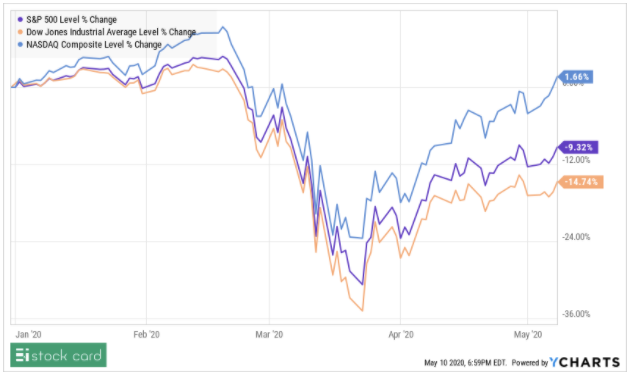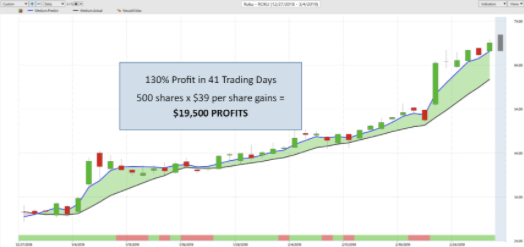
Positive YTD Gain
Hey Scoopers,
The Nasdaq index is back in the year-to-date (YTD) green zone, despite the possibility that the worst of the COVID-19 economic impact is yet to come. — More on that in the “Overall Market” section.
Beyond the overall market, one company got a boost from short-sellers, and a well-performing tech IPO saw investors’ sell-off despite a fantastic performance. — More on that in the “What’s Up?” and “What’s Down?” sections.
Oh, by the way, do you know which stocks are the true dividend-paying stocks? — More on that in the “Water Cooler” section.
But, first, here is a recap of what happened in the market yesterday:
Market Recap

- U.S. markets: All three indices ended last week in the green zone. Scroll down to the “Overall Market” section to read more.
- Cryptocurrency: The five-day return of Bitcoin was negative, although Bitcoin’s price is still quite higher than where it started the year.
![]()
Financial pandemic 2020
The Crash of 2020 is here, and it’s happening more quickly than virtually any crash in history.
Consider this: The coronavirus outbreak started in December of 2019. By March 2020, more than 110,000 people in 60 countries were infected.
![]()
Back To The Green

With more than 6% gain by the Nasdaq during last week, the index’s year-to-date return is now nearly 2%. What Nasdaq has lost during the pandemic, it has regained and then some.

Experts and officials continue to warn investors of the possibility that the worst of the economic impact is yet to come. For now, the stock market is the best place for investors to generate a return and take advantage of the rather liquid nature of the stock market in the short-term.
![]()
Covering Their Short Orders
So, what happened?
Shares of Revolve Group (Ticker: RVLV) were up more than 25% on Friday. The company is an online clothing retailer born in and fueled by the era of social media influencers and Instagram celebrities. On Friday, there was no good news to justify the stock’s upward jump. The best explanation is that investors and traders are expecting a better than expected earnings report on May 13th. In preparation for such earnings, they are covering their earlier short orders to avoid losing money after a possible positive earnings report. We have to wait and see what happens on the 13th.
Conquer Volatility
Stock market have you nervous with all the massive fluctuations?
With the impact of Coronavirus, Interest Rate Cuts and the Election it’s virtually impossible to guess what will happen next.
With Vantagepoint you don’t have to. Find out how our technology can forecast market trend changes with up to 87.4% accuracy.
![]()
Higher Revenue, Disappointed Investors
So, what happened?
Shares of Cloudflare (Ticker: NET) were down more than 11% on Friday. The company is a recent technology IPO that announced its latest quarterly earnings report on May 7th. The price drop is surprising because the company announced a 50% revenue growth. The company has more than 75% gross profit and the demand for the company’s products and services is even higher during the COVID-19 pandemic. The company is not profitable yet, but it generates free cash flow and has near two years of operating expenses in cash. We can’t tell you why investors are selling beyond the possibility that they are cashing out to lock some gains.
![]()
What Is A True Dividend-Paying Stock?

So what happened here?
Some times, companies with strong operations and enough cash at hand share their success with their shareholders in the form of a dividend. Many investors use dividend payout as a source of side income or reinvest the money to grow their investments. But not every dividend-paying stock is worth investing in.
How to pick true dividend-paying stocks?
Finding reliable dividend-paying stocks is not just about searching for companies that pay a dividend. You also need to weed out those companies that cannot sustain their dividend payout and focus on those that have a reliable history of growing their dividend yield. Some of the key filters you would need to use are:
- Dividend per share growth > 1% in the last 1, 3, and 6 years.
- Payout ratio < 75%. Healthy dividend-paying companies fund their dividends from their earnings and leave some money to reinvest in the company. Note that these criteria tend to filter out many REITs that have a higher payout ratio due to their accounting practices.
- Financial debt to EBITDA ratio < 3 and > 0 – To make sure the company’s financial debt is manageable, and it has a rather easy path to pay off its debt without crumbling under the debt pressure.
And, that’s how you focus on companies that not only pay a dividend but also can keep paying it without disruption.
P.S. A more comprehensive version of this analysis is posted on Stock Card’s blog, and you can access the list of 91 true dividend-paying stocks on Stock Card’s website for free.
Do you subscribe to a digital newspaper? Let us know by emailing us at members@tradestocks.com.




















